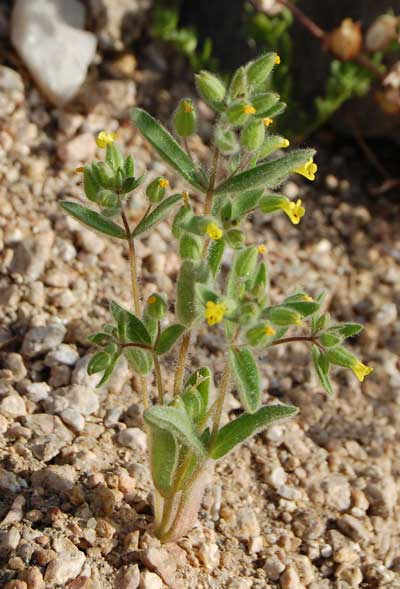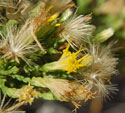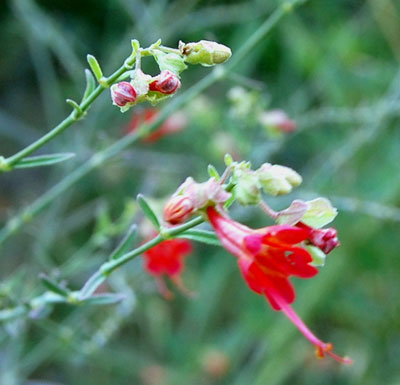Spring Wildflowers (obs. May 2008)
Red Flowers
- Indian Paintbrush -- Castilleja applegatei
- Hackberry Beard-tongue -- Pentstemon subulatus
- Red Brome Grass -- Bromus rubens
Orange Flowers
- Orange Fiddleneck -- Amsinckia intermedia
- California Poppy -- Eschscholzia californica
- Desert Globe Mallow -- Sphaeralcia ambigua
White Flowers
- Abert's Buckwheat -- Eriogonum abertianum
- Prickly Poppy -- Argemone spp. spp.
- Peppergrass -- Lepidium lasiocarpum
- Sacred Datura -- Datura wrightii
- Horehound -- Marrubium vulgare
- Fleabane -- Erigeron sp.
- Spurges -- Chamaesyce spp.
Greenish Flowers
- Prostrate Pigweed -- Amaranthus albus
- Beardless Rabbitfoot Grass -- Polypogon viridis
- Water Bentgrass -- Agrostis semiverticillata
- Wild Oats -- Avena fatua
- Woolly Plantain -- Plantago patagonica
- Burstwort -- Herniaria cinerea
Purple/Blue Flowers
- Bigelow's Aster -- Machaeranthera bigelovii
- Water Speedwell -- Veronica anagallis-aquatica
- Nutall's Snapdragon -- Antirrhinum nutallianum
- Chia -- Salvia columbariae
- Wild Petunia -- Calibrachoa parviflora
Pink/Lavender Flowers
- Paiute False Bindweed -- Calystegia longipes
- Dakota Mock Vervain -- Glandularia pinnatifida
- New Mexico Thistle -- Cirsium neomexicanum
- Red-stemmed Fillaree -- Erodium cicutarium
- Yellowthroat Gilia -- Gilia flavocincta
Yellow/Cream Flowers
- Stick-leaf -- Mentzelia pumila
- Twinberry -- Menodora scabra
- Chaparral Honeysuckle -- Lonicera interupta
- Foothill Deervetch -- Lotus humistratus
- Downy Monkeyflower -- Mimetanthe pilosa
- Pineapple Weed -- Matricaria discoidea
- London Rocket -- Sisymbrium irio
- Whispering Bells -- Emmenanthe penduliflora
- California Sundrop -- Camissonia californica

There is a great variety of yellow flowers to be found in the Sonoran Desert. This one is Downy Monkeyflower which tends to grow in damp sandy soil not far from the wash.

